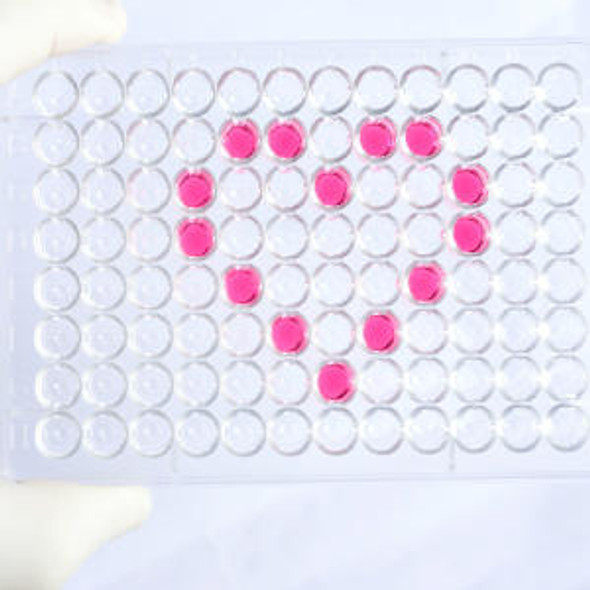Anti-SEPT5 Antibody (CAB12953)
- SKU:
- CAB12953
- Product type:
- Antibody
- Reactivity:
- Human
- Mouse
- Rat
- Host Species:
- Rabbit
- Isotype:
- IgG
- Antibody Type:
- Polyclonal Antibody
- Research Area:
- Cell Cycle
Frequently bought together:
Description
| Antibody Name: | Anti-SEPT5 Antibody |
| Antibody SKU: | CAB12953 |
| Antibody Size: | 20uL, 50uL, 100uL |
| Application: | WB IHC IF |
| Reactivity: | Human, Mouse, Rat |
| Host Species: | Rabbit |
| Immunogen: | Recombinant fusion protein containing a sequence corresponding to amino acids 1-369 of human SEPT5 (NP_002679.2). |
| Application: | WB IHC IF |
| Recommended Dilution: | WB 1:500 - 1:2000 IHC 1:100 - 1:200 IF 1:50 - 1:200 |
| Reactivity: | Human, Mouse, Rat |
| Positive Samples: | Jurkat, NIH/3T3, Mouse brain, Mouse heart, Mouse kidney, Rat brain |
| Immunogen: | Recombinant fusion protein containing a sequence corresponding to amino acids 1-369 of human SEPT5 (NP_002679.2). |
| Purification Method: | Affinity purification |
| Storage Buffer: | Store at -20°C. Avoid freeze / thaw cycles. Buffer: PBS with 0.02% sodium azide, 50% glycerol, pH7.3. |
| Isotype: | IgG |
| Sequence: | MSTG LRYK SKLA TPED KQDI DKQY VGFA TLPN QVHR KSVK KGFD FTLM VAGE SGLG KSTL VHSL FLTD LYKD RKLL SAEE RISQ TVEI LKHT VDIE EKGV KLKL TIVD TPGF GDAV NNTE CWKP ITDY VDQQ FEQY FRDE SGLN RKNI QDNR VHCC LYFI SPFG HGLR PVDV GFMK ALHE KVNI VPLI AKAD CLVP SEIR KLKE RIRE EIDK FGIH VYQF PECD SDED EDFK QQDR ELKE SAPF AVIG SNTV VEAK GQRV RGRL YPWG IVEV ENQA HCDF VKLR NMLI RTHM HDLK DVTC DVHY ENYR AHCI QQMT SKLT QDSR MESP IPIL PLPT PDAE TEKL IRMK DEEL RRMQ EMLQ RMKQ QMQD Q |
| Gene ID: | 5413 |
| Uniprot: | Q99719 |
| Cellular Location: | Cytoplasm, cytoskeleton |
| Calculated MW: | 39kDa/42kDa |
| Observed MW: | 43kDa |
| Synonyms: | SEPT5, CDCREL, CDCREL-1, CDCREL1, H5, HCDCREL-1, PNUTL1, septin-5 |
| Background: | This gene is a member of the septin gene family of nucleotide binding proteins, originally described in yeast as cell division cycle regulatory proteins. Septins are highly conserved in yeast, Drosophila, and mouse and appear to regulate cytoskeletal organization. Disruption of septin function disturbs cytokinesis and results in large multinucleate or polyploid cells. This gene is mapped to 22q11, the region frequently deleted in DiGeorge and velocardiofacial syndromes. A translocation involving the MLL gene and this gene has also been reported in patients with acute myeloid leukemia. Alternative splicing results in multiple transcript variants. The presence of a non-consensus polyA signal (AACAAT) in this gene also results in read-through transcription into the downstream neighboring gene (GP1BB; platelet glycoprotein Ib), whereby larger, non-coding transcripts are produced. |
| UniProt Protein Function: | SEPT5: Filament-forming cytoskeletal GTPase. May play a role in cytokinesis (Potential). May play a role in platelet secretion. Belongs to the septin family. 2 isoforms of the human protein are produced by alternative splicing. |
| UniProt Protein Details: | Protein type:Cell cycle regulation; Hydrolase; Vesicle; Cytoskeletal Chromosomal Location of Human Ortholog: 22q11.21 Cellular Component: synaptic vesicle; cytoskeleton; plasma membrane; terminal button; cell cortex Molecular Function:GTPase activity; protein binding; GTP binding; structural molecule activity Biological Process: regulation of exocytosis; metabolic process; cytokinesis; synaptic vesicle targeting |
| NCBI Summary: | This gene is a member of the septin gene family of nucleotide binding proteins, originally described in yeast as cell division cycle regulatory proteins. Septins are highly conserved in yeast, Drosophila, and mouse and appear to regulate cytoskeletal organization. Disruption of septin function disturbs cytokinesis and results in large multinucleate or polyploid cells. This gene is mapped to 22q11, the region frequently deleted in DiGeorge and velocardiofacial syndromes. A translocation involving the MLL gene and this gene has also been reported in patients with acute myeloid leukemia. Alternative splicing results in multiple transcript variants. The presence of a non-consensus polyA signal (AACAAT) in this gene also results in read-through transcription into the downstream neighboring gene (GP1BB; platelet glycoprotein Ib), whereby larger, non-coding transcripts are produced. [provided by RefSeq, Dec 2010] |
| UniProt Code: | Q99719 |
| NCBI GenInfo Identifier: | 6685760 |
| NCBI Gene ID: | 5413 |
| NCBI Accession: | Q99719.1 |
| UniProt Secondary Accession: | Q99719,Q9Z2Q6, Q9JJM9, |
| UniProt Related Accession: | Q99719 |
| Molecular Weight: | 369 |
| NCBI Full Name: | Septin-5 |
| NCBI Synonym Full Names: | septin 5 |
| NCBI Official Symbol: | SEPT5 |
| NCBI Official Synonym Symbols: | H5; CDCREL; PNUTL1; CDCREL1; CDCREL-1; HCDCREL-1 |
| NCBI Protein Information: | septin-5; peanut-like 1; platelet glycoprotein Ib beta chain; cell division control related protein 1 |
| UniProt Protein Name: | Septin-5 |
| UniProt Synonym Protein Names: | Cell division control-related protein 1; CDCrel-1; Peanut-like protein 1 |
| UniProt Gene Name: | SEPT5 |
| UniProt Entry Name: | SEPT5_HUMAN |













